SOM has long maintained close and dynamic relationships with many of the greatest modern artists of the era. One sculptor whose work was particularly well suited to SOM’s public and corporate spaces was Alexander Calder, warmly known to the architects who worked with him as “Sandy.”
From 1948 to 1975, Calder created artwork for 10 buildings designed by SOM. At age 50, he produced his first commission for the firm: a mobile installed in the lobby of Cincinnati’s Terrace Plaza Hotel. The piece was named “Twenty Leaves and an Apple.” Made of sheet metal and piano wire, it is similar to the kinetic, hanging mobiles that characterize Calder’s earlier work. Calder wanted the space, shadows, and patterns created by the movement of the sculpture’s counterpoints to reflect reality’s innate dynamism.
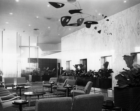
After this initial commission, Calder designed mobiles for SOM’s Chase Manhattan Bank at 410 Park Avenue, John F. Kennedy Airport International Arrivals Building, and Fourth Financial Center, among other buildings. These suspended organic forms revolutionized sculpture, as they were designed to respond to the environment and flow of air as people moved through the spaces.
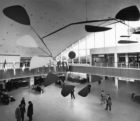

Named “.125” after the gauge of the aluminum wire used in the piece, this 45-foot-long mobile — originally hung from the John F. Kennedy Airport International Arrivals Building, which opened in 1957, and now lives inside the current-day Terminal 4, which opened in 2001. The sculpture draws travelers into the heart of the airport and reinforces the building’s iconic image of elegant and efficient air travel. This large yet delicate and precisely balanced sculpture evokes images of wings, wind, and flight as it moves in response to subtle air currents. The form, color, and movement of the angular steel plates are juxtaposed and carefully balanced into a harmonious whole.
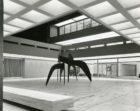
In the 1960s, Calder’s focus shifted to monumental civic sculpture. “Le Guichet,” French for “ticket seller’s window,” was installed in a plaza in New York City’s Lincoln Center. Visitors were invited to approach, wander around, and study the 14-foot-tall stabile. The sculpture exemplifies Calder’s distinctive ability to use industrial materials and fabrication methods to create abstract forms that evoke nature, animals, and play.
“The Spunk of the Monk” derives its name from the city where it was installed: Des Moines, which is French for “of the monks.” Commissioned in 1984 for the American Republic Insurance Headquarters, this massive black-painted steel stabile stood for years in the company courtyard (it has since been relocated). Viewers can walk under and through the irregular negative space created by seven arched “legs,” lending to the sculpture’s sense of movement and change.
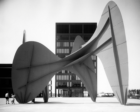
“La Grande Vitesse,” installed in the plaza in front of the SOM-designed Vandenberg Center (1989) in Grand Rapids, Michigan, was the first public sculpture funded by the National Endowment for the Arts. Weighing 42 tons and standing four stories high, the steel abstraction seems to transform and shift as viewers move around and through the curving arches. Painted in Calder’s signature red, “La Grande Vitesse” was intended to enhance and strengthen civic pride. Calder’s sculpture became a ubiquitous symbol of Grand Rapids, with its arched silhouette featured on everything from the city’s letterhead to its garbage trucks.
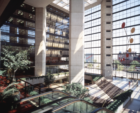
In 1975, Calder created “Eléments Démontables” for the Fourth Financial Bank and Trust Company in Wichita, Kansas. The sculpture measures 47 feet and swings to the movement of the surrounding air. “Eléments Démontables” is the centerpiece of the building’s nine-story, full-height glass atrium. Now known as the Bank of America Financial Center, the SOM-designed building became a catalyst for the renewal of the city’s central business district. By exploring the relation between form, color, and movement, Calder was able to combine playful subject matter, primary colors, and abstract shapes to create accessible works that are captivating and engaging.
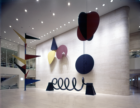
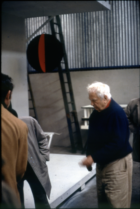
Among Calder’s last projects was an installation in the lobby of the world’s tallest building at the time: the SOM-designed Sears Tower (now Willis Tower). “Universe” depicts the “big bang” of creation through a series of kinetic steel sculptures that represent the heavenly bodies and spin in perpetual motion. Unveiled in 1974, “Universe” embodies Calder’s aesthetic philosophy as he described it over 40 years earlier. In the 1932 edition of the journal Abstraction-Creation, Calder explained: “How can art be realized? Out of volumes, motion, spaces bound by the great space, the universe.”
Calder’s kinetic art and monumental public sculptures have profoundly influenced the role of modern art in everyday life. SOM architects and designers who worked with him – including Gordon Bunshaft, Bruce Graham, and David Allen – described Calder as a generous and engaging man whose sense of humor and warmth shined through in his artwork. Certainly, Calder’s impact is still felt today.
[Top image: Calder and Bruce Graham look over “Universe” prior to installation.]
